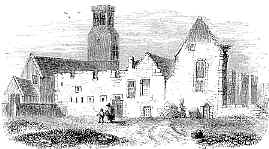
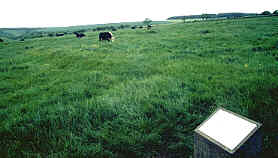
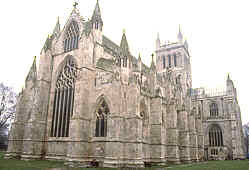
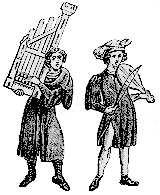
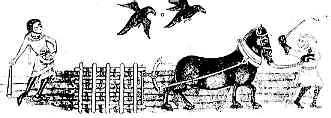
If you are looking at this page without frames, there is more information about medieval writing to be found by going to the home page (framed) or the site map (no frames).
| Manuscripts as Historical Sources | ||||
| Material preserved in manuscript form is the primary source databank of written material from the middle ages. Manuscripts provide not only the most authentic witnesses to life in the medieval era, but also a record of what aspects of life were considered to be of sufficient importance to immortalise in the medium. In an era of only partial literacy, when the transmission of written knowledge was laborious, the value of that knowledge to society can be evaluated by the care and elegance of its recording, or even by the fact that it was recorded at all. | ||||
| The concept of a primary source is subject to much simplification. Every manuscript written in the medieval era is an authentic artifact of that era. However, every manuscript was not penned by its author, and every author was not a living witness to the events he or she penned. Historians existed in the medieval era, chronicling events of many generations past. Their selections, their attitudes and their prejudices represent primary source material for their time, even if the stories they wrote were seen through the filter of legend. (See Bagley 1972) The remains of the monastery of Jarrow are a compilation of many centuries, as the works of Bede were an assemblage from many centuries, but an authentic witness to the attitudes of the early church in England. |
 |
|||
| A romantic view of the ruins of Jarrow. | ||||
 |
The particular concerns of medieval authors can tell us much about their value systems. However, they left some blanks in their record. After all, they were writing for their times, not for curious readers hundreds of years in the future. Archaeologists investigate many angles which are not covered by the written records, and that can give us some comparison between the life of the mind and life in the cold, hard world. The deserted medieval village of Wharram Percy in Yorkshire was investigated by archaeologists for over 30 years, revealing many aspects of village life not perpetuated in written records. | |||
| The site of Wharram Percy, bumps in a field, cows and an explanatory sign. | ||||
| Written records can be used in a diversity of ways to make inferences about historical questions which could not have been further from the minds of the scribes who penned the words. Financial and legal records are a mine of information about social history, with a little help from an interpreter. The granting of privileges or the dispensing of justice reveals much about social conditions, relations and expectations. The church, when seen in its role as major business enterprise, shows its relationship to the world of politics, work and community. The Benedictine Abbey of Selby in Yorkshire has left little for archaeologists, all but its church having vanished under later building, but it has left a set of accounts that tell much about daily life and work in the community and the town. (Tillotson 1988) |  |
|||
| The Benedictine Abbey of Selby, or what is left of it today. | ||||
 |
The nature of manuscripts as historical sources changes during the course of the medieval era. As literacy spread from the monasteries to a gradually increasing proportion of the population, a greater variety of literary works appeared in manuscript form. We learn about more aspects of the life of the mind as the middle ages progresses, while much of that of the earlier period has evaporated with its oral culture. | |||
| Also in greater profusion in the later part of the middle ages are legal documents, financial records and the written records of various levels of government. Personal letters make an appearance at the end of the middle ages. Their survival takes the viewpoint of history from the formal and institutional to the individual and personal level. | ||||
| The historical record of manuscripts traces the development of literacy from an exclusive and narrowly focused preserve of the learned, mostly living separate from the rest of society, to an instrument of education, entertainment and bureaucracy within society as a whole. Although literacy was not universal at any stage during the medieval era, the management of society became dependent on literacy and on the literate. The historical questions which can be addressed through manuscript studies broaden as the era progresses, and areas that were the preserve of the archaeologist can draw evidence from the literate mode. | ||||
| Many collections of manuscripts have been reproduced in printed form for historical study. However, while these have their value, they have been subject to an extra layer of interpretation before being presented for analysis. Selection, editing, transcription and translation all remove the serious historian further from the true corpus of available data. | ||||
| Manuscripts can be studied not only for the content of their texts; they are also part of visual culture. As well as reading, we can look. Stylistic attributes of the art work can be studied in the manner of an art historian to elucidate routes of influence and transmission and determine the relationships between cultures. Many illustrations in manuscripts depict aspects of the culture and society of the day, through the filter of what was considered appropriate. A medieval historian, of whatever specialised persuasion, cannot avoid involvement with original manuscripts. | ||||
 |
||||
| Seed sowing, from the Luttrell Psalter, now in the British Library. (From New Paleaographical Society 1904) | ||||
|
|
||||
|
If you are looking at this page without frames, there is more information about medieval writing to be found by going to the home page (framed) or the site map (no frames). |
||||